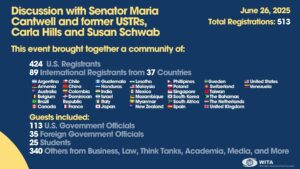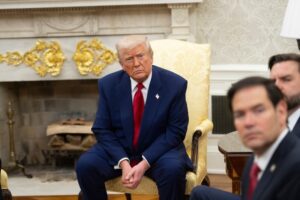Discussion with Senator Maria Cantwell and former USTRs, Carla Hills and Susan Schwab
With rising global economic tensions and the growing use of tariffs, thank you for joining WITA as we welcomed U.S. Senator Maria Cantwell (D-WA) for a discussion with former United States Trade Representatives Carla Hills and Susan Schwab. The Senator and the Ambassadors discussed American competitiveness and trade in an evolving global economic landscape.
Featured Speakers:
U.S. Senator Maria Cantwell (D-WA), Ranking Democrat on the Senate Commerce Committee; member of the Senate Finance Committee
Ambassador Carla Hills, Chair & CEO, Hills & Company International Consultants; former U.S. Trade Representative
Ambassador Susan Schwab, Strategic Advisor, Mayer Brown; former United States Trade Representative
Moderator: Nasim Fussell, Vice President of Trade and International, Business Roundtable; former Chief Trade Counsel, U.S. Senate Finance Committee

Navigating the Trade Policy ‘Air Pocket’

The global economy may be headed for an ‘air pocket’ — a period when the drag from tariffs sets in before any potential policy offsets, such as tax cuts or deregulation, have time to take effect.
The coming months will test the resilience of post-pandemic expansion. For investors, many of whom are facing tariffs and economic mercantilism for the first time, this presents both a challenge and an opportunity. Those able to identify new growth drivers in this fast-evolving environment will be well-positioned to benefit.
Tariff disruptions are already happening. Even though we don’t know where policy will ultimately land, the uncertainty alone is affecting supply chains and pricing. Meanwhile, any fiscal offsets, such as tax cuts, likely won’t be enacted until late summer or early autumn. As for the positive impacts of US deregulation, the timeline is even more uncertain, and any economic boost would take time to filter through.
In other words, we may still be entering the air pocket, but disruptions have already begun, although policy support hasn’t arrived yet.
In the first quarter of 2025, US private domestic demand held up reasonably well, with consumption (1.2 per cent) and investment (1.3 per cent) combining to bring growth to 2.5 per cent. That represents only a modest deceleration from the pace of the prior three quarters. What made it different was the drag from inventories, which essentially offset the entirety of private domestic demand growth. The key question is, what caused the run-up in inventories?
Read the Full Opinion Here
06/13/2025 | Olga Bitel | Professional Wealth Management
A New Trade Paradigm: How Shifts in Trade Corridors Could Affect Business

About that grinding sound you’ve been hearing: Not to alarm you, but that’s the tectonic plates of global trade shifting. Every business leader we speak with confirms that the current trade environment is the most uncertain in their lifetimes. Between momentous tariff hikes (and cuts and litigation), the return and spread of industrial policy, rising geopolitical tensions, and all the other disruptions of this digitizing, pandemic-scarred age, the system is in massive flux.
The unpredictability is forcing leaders to question long-held assumptions about where and how they operate. Global business systems—the footprint of factories, suppliers, warehouses, distribution centers, and the entire apparatus of making things and getting them to market—have long since been optimized for efficiency. Now, their owners are wondering if the systems will still work and what the new costs will be.
In a moment like this, it’s easy to get lost in the headlines. But the real task is to understand the deeper, structural shifts at play. Trade patterns have significant inertia; they generally evolve slowly. Some signs of such an evolution have been evident since 2017, as big trading economies have adapted to shifts in geopolitics. These new geopolitical dynamics add an unpredictable element to the steadier forces of economic growth.
Secular changes in trade patterns can be detected through shifts in trade corridors—the connections between countries to exchange goods, services, and resources. Our research finds that in a baseline scenario with tariffs at recent historical levels, global trade of goods, services, and resources would grow by about $12 trillion in real terms to $45 trillion by 2035, up from $33 trillion in 2024.
We also examine two out of many possible scenarios, both intended to bound uncertainty rather than to describe a precise future. In a fragmentation scenario, trade relationships deteriorate, and tariffs on most goods rise to 10 percent, with tariffs on critical goods traded between many advanced economies and China and Russia rising by up to 60 percent. Should that scenario unfold, about $3 trillion of the nearly $12 trillion in growth would be lost. On the other hand, in a diversification scenario, in which businesses prize resilience and diversify their suppliers, about $1 trillion in potential trade growth would be foregone.
Read the Full Article Here
06/18/2025 | Jeongmin Seong, Olivia White, Shivanshu Gupta, Asutosh Padhi, Brajesh Chhibber, Jeffrey Condon & Tiago Devesa | McKinsey & Company
The Economic Consequences of the Second Trump Administration: A Preliminary Assessment

While sweeping tariffs, sharp breaks in global alliances, and risks to the rule of law may have garnered the most attention, there has been a flurry of other activity affecting the economy. This has included significant policy shifts on immigration, deportations, birthright citizenship, downsizing government, as well as cuts in science funding, foreign aid, and academic support. Dramatic changes to health programmes and tax policies are working their way through Congress and the administration. The declining US fiscal picture, challenges to international alliances, tariff wars, questions of Federal Reserve independence, and deregulatory financial sector policies also have raised concerns about the sustainability of the global dollar-based system.
Though the US and global capital markets have shown resilience to date, early indicators point to economic turbulence ahead. Investment, inflation, and supply chain risks all have increased. Businesses, financial parties, foreign countries, and the public naturally are assessing what this all means for their economic futures.
The US also is retreating from its historic role in supplying key global public goods – on trade, national security, rule of law, basic research, and the dollar – that have underpinned both domestic and international prosperity for decades. Though the full impact of declining US leadership may take time to unfold – as institutions and economies adjust to a less stable international order – such deep policy shifts are likely to have negative consequences over the medium to longer term.
The new administration has occasionally softened controversial policies in reaction to equity or bond market reactions, such as in April when it delayed reciprocal tariffs for 90 days. The market recovery since then, however, does not necessarily indicate smooth sailing on the horizon.
To the extent that the administration interprets current financial markets as a green light, such interpretation may encourage policies that undermine long-run growth. Over time, the cumulative effect may be a profound weakening of both US economic dynamism and the global system it once led.
Read the Full Column Here
06/18/2025 | Gary Gensler, Simon Johnson, Ugo Panizza & Beatrice Weder di Mauro | Centre for Economic Policy Research
WITA – We put the community in trade community.
Information about upcoming WITA and trade community events



